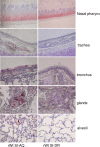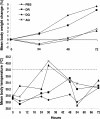Influenza H1N1 A/Solomon Island/3/06 virus receptor binding specificity correlates with virus pathogenicity, antigenicity, and immunogenicity in ferrets
- PMID: 20200248
- PMCID: PMC2863823
- DOI: 10.1128/JVI.02489-09
Influenza H1N1 A/Solomon Island/3/06 virus receptor binding specificity correlates with virus pathogenicity, antigenicity, and immunogenicity in ferrets
Abstract
Influenza viruses attach to cells via a sialic acid moiety (sialic acid receptor) that is alpha2-3 linked or alpha2-6 linked to galactose (alpha2-3SAL or alpha2-6SAL); sialic acid acts as a receptor for the virus. Using lectin staining, we demonstrated that the alpha2-6SAL configuration is predominant in the respiratory tract of ferrets, including trachea, bronchus, and lung alveolus tissues. Recombinant wild-type (rWT) influenza A/Solomon Island/3/06 (SI06) (H1N1) viruses were constructed to assess the impact of the hemagglutinin (HA) variations (amino acids 190 or 226) identified in natural variants on virus replication in the upper and lower respiratory tract of ferrets, as well as virus antigenicity and immunogenicity. A single amino acid change at residue 226 (from Gln to Arg) in the HA of SI06 resulted in the complete loss of binding to alpha2-6SAL and a concomitant loss of the virus's ability to replicate in the lower respiratory tract of ferrets. In contrast, the virus with Gln226 in the HA protein has a receptor binding preference for alpha2-6SAL and replicates efficiently in the lungs. There was a good correlation between viral replication in the lungs of ferrets and disease symptoms. In addition, we also showed that the 190 and 226 residues affected viral antigenicity and immunogenicity. Our data emphasize the necessity of thoroughly assessing wild-type influenza viruses for their suitability as reference strains and for carefully selecting the HA antigen for vaccine production during annual influenza vaccine evaluation processes.
Figures





Similar articles
-
Glycosylation at 158N of the hemagglutinin protein and receptor binding specificity synergistically affect the antigenicity and immunogenicity of a live attenuated H5N1 A/Vietnam/1203/2004 vaccine virus in ferrets.J Virol. 2010 Jul;84(13):6570-7. doi: 10.1128/JVI.00221-10. Epub 2010 Apr 28. J Virol. 2010. PMID: 20427525 Free PMC article.
-
Receptor specificity does not affect replication or virulence of the 2009 pandemic H1N1 influenza virus in mice and ferrets.Virology. 2013 Nov;446(1-2):349-56. doi: 10.1016/j.virol.2013.08.011. Epub 2013 Sep 10. Virology. 2013. PMID: 24074599 Free PMC article.
-
The soft palate is an important site of adaptation for transmissible influenza viruses.Nature. 2015 Oct 1;526(7571):122-5. doi: 10.1038/nature15379. Epub 2015 Sep 23. Nature. 2015. PMID: 26416728 Free PMC article.
-
Influenza B Virus Receptor Specificity: Closing the Gap between Binding and Tropism.Viruses. 2024 Aug 24;16(9):1356. doi: 10.3390/v16091356. Viruses. 2024. PMID: 39339833 Free PMC article. Review.
-
Sialic acid tissue distribution and influenza virus tropism.Influenza Other Respir Viruses. 2008 Sep;2(5):147-54. doi: 10.1111/j.1750-2659.2008.00051.x. Influenza Other Respir Viruses. 2008. PMID: 19453419 Free PMC article. Review.
Cited by
-
Cross talk between animal and human influenza viruses.Annu Rev Anim Biosci. 2013 Jan;1:21-42. doi: 10.1146/annurev-animal-031412-103733. Epub 2013 Jan 1. Annu Rev Anim Biosci. 2013. PMID: 25387011 Free PMC article. Review.
-
Mutations Driving Airborne Transmission of A/H5N1 Virus in Mammals Cause Substantial Attenuation in Chickens only when combined.Sci Rep. 2017 Aug 3;7(1):7187. doi: 10.1038/s41598-017-07000-6. Sci Rep. 2017. PMID: 28775271 Free PMC article.
-
Sequential Transmission of Influenza Viruses in Ferrets Does Not Enhance Infectivity and Does Not Predict Transmissibility in Humans.mBio. 2022 Dec 20;13(6):e0254022. doi: 10.1128/mbio.02540-22. Epub 2022 Oct 27. mBio. 2022. PMID: 36300929 Free PMC article.
-
The role of receptor binding specificity in interspecies transmission of influenza viruses.Curr Opin Virol. 2012 Apr;2(2):160-7. doi: 10.1016/j.coviro.2012.03.003. Epub 2012 Mar 24. Curr Opin Virol. 2012. PMID: 22445963 Free PMC article. Review.
-
Evaluation of live attenuated H7N3 and H7N7 vaccine viruses for their receptor binding preferences, immunogenicity in ferrets and cross reactivity to the novel H7N9 virus.PLoS One. 2013 Oct 9;8(10):e76884. doi: 10.1371/journal.pone.0076884. eCollection 2013. PLoS One. 2013. PMID: 24130801 Free PMC article.
References
-
- Bateman, A. C., M. G. Busch, A. I. Karasin, N. Bovin, and C. W. Olsen. 2008. Amino acid 226 in the hemagglutinin of H4N6 influenza virus determines binding affinity for alpha2,6-linked sialic acid and infectivity levels in primary swine and human respiratory epithelial cells. J. Virol. 82:8204-8209. - PMC - PubMed
-
- Chen, H., R. A. Bright, K. Subbarao, C. Smith, N. J. Cox, J. M. Katz, and Y. Matsuoka. 2007. Polygenic virulence factors involved in pathogenesis of 1997 Hong Kong H5N1 influenza viruses in mice. Virus Res. 128:159-163. - PubMed
-
- Chen, W., P. A. Calvo, D. Malide, J. Gibbs, U. Schubert, I. Bacik, S. Basta, R. O'Neill, J. Schickli, P. Palese, P. Henklein, J. R. Bennink, and J. W. Yewdell. 2001. A novel influenza A virus mitochondrial protein that induces cell death. Nat. Med. 7:1306-1312. - PubMed
MeSH terms
Substances
LinkOut - more resources
Full Text Sources
Other Literature Sources

